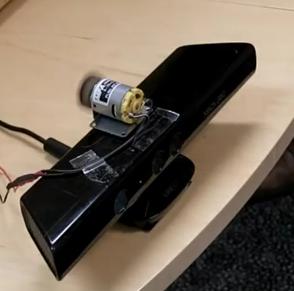"Multiple Kinects tend to interfere with one another. A Kinect measures the depth of a point by projecting a pattern of infrared dots into the scene and detecting how far they appear shifted due to parallax. This is great when there is only one Kinect but if you have more than one there is no way of separating out their dots. What this means is that one Kinect could project an infrared dot that another Kinect "sees" as its own and hence incorrectly estimates the distance."Solutions:
- Time division multiplexing approach
Schroder et al. [1] implemented a time decision multiplexing approach, where IR emitter on each Kinect is blocked in turn so that the IR pattern don't interfere. However, the frame rate of depth images are reduces with the number of Kinects.
- Shake n Sense (moving Kinect)
- Hole filling algorithm
Instead of preventing the interference, Maimone and Fuchs [3] used a hole filling algorithm to fill missing depth caused by the interference and median filtering to reduce the noise. Their system can present real-time merging of the data from multiple Kinect and keep frame rate at 30 fps.
Reference:
Kinect Hacking:
http://idav.ucdavis.edu/~okreylos/ResDev/Kinect/
http://social.msdn.microsoft.com/Forums/en-US/kinectsdknuiapi/thread/a9635450-5ab6-4166-8391-75921e7f7ccf
https://groups.google.com/forum/?fromgroups=#!topic/openni-dev/IDVsj42ezKg
- Schroder, Y. and Scholz, A. and Berger, K. and Ruhl, K. and Guthe, S. and Magnor, M. Multiple kinect studies, Computer Graphics 2011.
- Butler, D.A. and Izadi, S. and Hilliges, O. and Molyneaux, D. and Hodges, S. and Kim, D., Shake'n'sense: reducing interference for overlapping structured light depth cameras, Proceedings of the 2012 ACM annual conference on Human Factors in Computing Systems.
- Maimone, A. and Fuchs, H. Encumbrance-free telepresence system with real-time 3d capture and display using commodity depth cameras, Mixed and Augmented Reality (ISMAR), 2011 10th IEEE International Symposium
Kinect Hacking:
http://idav.ucdavis.edu/~okreylos/ResDev/Kinect/
http://social.msdn.microsoft.com/Forums/en-US/kinectsdknuiapi/thread/a9635450-5ab6-4166-8391-75921e7f7ccf
https://groups.google.com/forum/?fromgroups=#!topic/openni-dev/IDVsj42ezKg


No comments:
Post a Comment